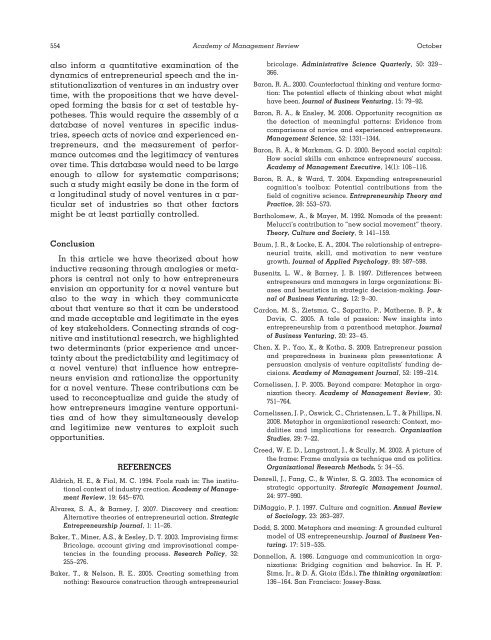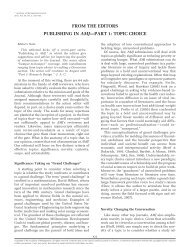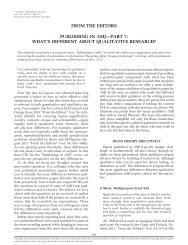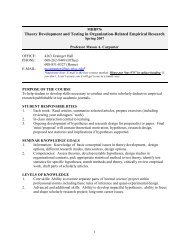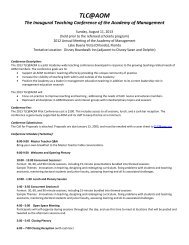inductive reasoning and the creation and justification of new ventures
inductive reasoning and the creation and justification of new ventures
inductive reasoning and the creation and justification of new ventures
You also want an ePaper? Increase the reach of your titles
YUMPU automatically turns print PDFs into web optimized ePapers that Google loves.
554 Academy <strong>of</strong> Management Review<br />
October<br />
also inform a quantitative examination <strong>of</strong> <strong>the</strong><br />
dynamics <strong>of</strong> entrepreneurial speech <strong>and</strong> <strong>the</strong> institutionalization<br />
<strong>of</strong> <strong>ventures</strong> in an industry over<br />
time, with <strong>the</strong> propositions that we have developed<br />
forming <strong>the</strong> basis for a set <strong>of</strong> testable hypo<strong>the</strong>ses.<br />
This would require <strong>the</strong> assembly <strong>of</strong> a<br />
database <strong>of</strong> novel <strong>ventures</strong> in specific industries,<br />
speech acts <strong>of</strong> novice <strong>and</strong> experienced entrepreneurs,<br />
<strong>and</strong> <strong>the</strong> measurement <strong>of</strong> performance<br />
outcomes <strong>and</strong> <strong>the</strong> legitimacy <strong>of</strong> <strong>ventures</strong><br />
over time. This database would need to be large<br />
enough to allow for systematic comparisons;<br />
such a study might easily be done in <strong>the</strong> form <strong>of</strong><br />
a longitudinal study <strong>of</strong> novel <strong>ventures</strong> in a particular<br />
set <strong>of</strong> industries so that o<strong>the</strong>r factors<br />
might be at least partially controlled.<br />
Conclusion<br />
In this article we have <strong>the</strong>orized about how<br />
<strong>inductive</strong> <strong>reasoning</strong> through analogies or metaphors<br />
is central not only to how entrepreneurs<br />
envision an opportunity for a novel venture but<br />
also to <strong>the</strong> way in which <strong>the</strong>y communicate<br />
about that venture so that it can be understood<br />
<strong>and</strong> made acceptable <strong>and</strong> legitimate in <strong>the</strong> eyes<br />
<strong>of</strong> key stakeholders. Connecting str<strong>and</strong>s <strong>of</strong> cognitive<br />
<strong>and</strong> institutional research, we highlighted<br />
two determinants (prior experience <strong>and</strong> uncertainty<br />
about <strong>the</strong> predictability <strong>and</strong> legitimacy <strong>of</strong><br />
a novel venture) that influence how entrepreneurs<br />
envision <strong>and</strong> rationalize <strong>the</strong> opportunity<br />
for a novel venture. These contributions can be<br />
used to reconceptualize <strong>and</strong> guide <strong>the</strong> study <strong>of</strong><br />
how entrepreneurs imagine venture opportunities<br />
<strong>and</strong> <strong>of</strong> how <strong>the</strong>y simultaneously develop<br />
<strong>and</strong> legitimize <strong>new</strong> <strong>ventures</strong> to exploit such<br />
opportunities.<br />
REFERENCES<br />
Aldrich, H. E., & Fiol, M. C. 1994. Fools rush in: The institutional<br />
context <strong>of</strong> industry <strong>creation</strong>. Academy <strong>of</strong> Management<br />
Review, 19: 645–670.<br />
Alvarez, S. A., & Barney, J. 2007. Discovery <strong>and</strong> <strong>creation</strong>:<br />
Alternative <strong>the</strong>ories <strong>of</strong> entrepreneurial action. Strategic<br />
Entrepreneurship Journal, 1: 11–26.<br />
Baker, T., Miner, A.S., & Eesley, D. T. 2003. Improvising firms:<br />
Bricolage, account giving <strong>and</strong> improvisational competencies<br />
in <strong>the</strong> founding process. Research Policy, 32:<br />
255–276.<br />
Baker, T., & Nelson, R. E.. 2005. Creating something from<br />
nothing: Resource construction through entrepreneurial<br />
bricolage. Administrative Science Quarterly, 50: 329–<br />
366.<br />
Baron, R. A., 2000. Counterfactual thinking <strong>and</strong> venture formation:<br />
The potential effects <strong>of</strong> thinking about what might<br />
have been. Journal <strong>of</strong> Business Venturing, 15: 79–92.<br />
Baron, R. A., & Ensley, M. 2006. Opportunity recognition as<br />
<strong>the</strong> detection <strong>of</strong> meaningful patterns: Evidence from<br />
comparisons <strong>of</strong> novice <strong>and</strong> experienced entrepreneurs.<br />
Management Science, 52: 1331–1344.<br />
Baron, R. A., & Markman, G. D. 2000. Beyond social capital:<br />
How social skills can enhance entrepreneurs’ success.<br />
Academy <strong>of</strong> Management Executive, 14(1): 106–116.<br />
Baron, R. A., & Ward, T. 2004. Exp<strong>and</strong>ing entrepreneurial<br />
cognition’s toolbox: Potential contributions from <strong>the</strong><br />
field <strong>of</strong> cognitive science. Entrepreneurship Theory <strong>and</strong><br />
Practice, 28: 553–573.<br />
Bartholomew, A., & Mayer, M. 1992. Nomads <strong>of</strong> <strong>the</strong> present:<br />
Melucci’s contribution to “<strong>new</strong> social movement” <strong>the</strong>ory.<br />
Theory, Culture <strong>and</strong> Society, 9: 141–159.<br />
Baum, J. R., & Locke, E. A., 2004. The relationship <strong>of</strong> entrepreneurial<br />
traits, skill, <strong>and</strong> motivation to <strong>new</strong> venture<br />
growth. Journal <strong>of</strong> Applied Psychology, 89: 587–598.<br />
Busenitz, L. W., & Barney, J. B. 1997. Differences between<br />
entrepreneurs <strong>and</strong> managers in large organizations: Biases<br />
<strong>and</strong> heuristics in strategic decision-making. Journal<br />
<strong>of</strong> Business Venturing, 12: 9–30.<br />
Cardon, M. S., Zietsma, C., Saparito, P., Ma<strong>the</strong>rne, B. P., &<br />
Davis, C. 2005. A tale <strong>of</strong> passion: New insights into<br />
entrepreneurship from a parenthood metaphor. Journal<br />
<strong>of</strong> Business Venturing, 20: 23–45.<br />
Chen, X. P., Yao, X., & Kotha, S. 2009. Entrepreneur passion<br />
<strong>and</strong> preparedness in business plan presentations: A<br />
persuasion analysis <strong>of</strong> venture capitalists’ funding decisions.<br />
Academy <strong>of</strong> Management Journal, 52: 199–214.<br />
Cornelissen, J. P. 2005. Beyond compare: Metaphor in organization<br />
<strong>the</strong>ory. Academy <strong>of</strong> Management Review, 30:<br />
751–764.<br />
Cornelissen, J. P., Oswick, C., Christensen, L. T., & Phillips, N.<br />
2008. Metaphor in organizational research: Context, modalities<br />
<strong>and</strong> implications for research. Organization<br />
Studies, 29: 7–22.<br />
Creed, W. E. D., Langstraat, J., & Scully, M. 2002. A picture <strong>of</strong><br />
<strong>the</strong> frame: Frame analysis as technique <strong>and</strong> as politics.<br />
Organizational Research Methods, 5: 34–55.<br />
Denrell, J., Fang, C., & Winter, S. G. 2003. The economics <strong>of</strong><br />
strategic opportunity. Strategic Management Journal,<br />
24: 977–990.<br />
DiMaggio, P. J. 1997. Culture <strong>and</strong> cognition. Annual Review<br />
<strong>of</strong> Sociology, 23: 263–287.<br />
Dodd, S. 2000. Metaphors <strong>and</strong> meaning: A grounded cultural<br />
model <strong>of</strong> US entrepreneurship. Journal <strong>of</strong> Business Venturing,<br />
17: 519–535.<br />
Donnellon, A. 1986. Language <strong>and</strong> communication in organizations:<br />
Bridging cognition <strong>and</strong> behavior. In H. P.<br />
Sims, Jr., & D. A. Gioia (Eds.), The thinking organization:<br />
136–164. San Francisco: Jossey-Bass.


